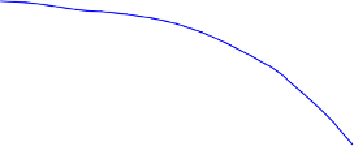Environmental Engineering Reference
In-Depth Information
Drawing the conclusion about the reliability of the Amsterdam North network, based on the
outlook of the corresponding HRD, the network is generally over designed and could
function properly with smaller diameters for majority of the pipes. To increase the reliability
on the other hand, one should concentrate on the couple of major pipes, alone. Seven of these
are the main reason for 24 % of the demand loss, which is the consequence of the worst pipe
failure scenario. How far this should be done, is a decision for the water company.
The seven most critical pipes identified by the developed network diagnostics software are (D
in mm/L in m): 15003 (800/18), 15004 (800/20), 15005 (800/19), 15006 (762/35), 15007
(769/320), 17824 (800/9) and 17825 (800/8). To demonstrate the implications of the network
renovation on the improvement of the three indices, a pipe of 800 mm diameter and 430 m
length has been connected between the node 14226, which is the first one (upstream) in the
series of seven pipes, and 12444 being the last one (downstream) and the major discharge
node of Q = 112.14 l/s. In this case, a parallel pipe has been added to the network
strengthening one of its branches towards the area of high demand. The results in Figure 5.28
show the improvement, with following values in the final simulation run, nr. 15: I
r
= 0.288, I
n
= 0.264, NBI = 0.500, ADF
avg
= 0.9941 and ADF
min
= 0.777.
1
0.9
0.8
0.7
Ir
In
NBI
ADFavg
ADFmin
0.6
0.5
0.4
0.3
0.2
0.1
0
1
2
3
4
5
6
7
8
9
10
11
12
13
14
15
Figure 5.28
Implication of network renovation on I
r
, I
n
and NBI (total demand incr. 73%)
While the values of
I
r
and
I
n
do not change significantly compared to the situation in Figure
5.25, the effect of having parallel pipe on a branch leading to the major demand node is
clearly captured in higher value of NBI in the first couple of simulations, being indirectly
influenced by much higher value of
ADF
min
compared to the original situation with single
branch. This effect is obviously diminished as the demand is growing so that the NBI value
towards the final simulation showing the demand increase of 73 % is less different than in the
first case.
5.9
CONCLUSIONS
The research presented in this chapter aims at alternative way of expressing the reliability
index being derived from a diagram showing the correlation between the pipe flows under the
regular supply conditions and the loss of demand caused by their failure. The proposed
diagram, called the hydraulic reliability diagram (HRD), considers the reliability of zero in







































































































Search WWH ::

Custom Search